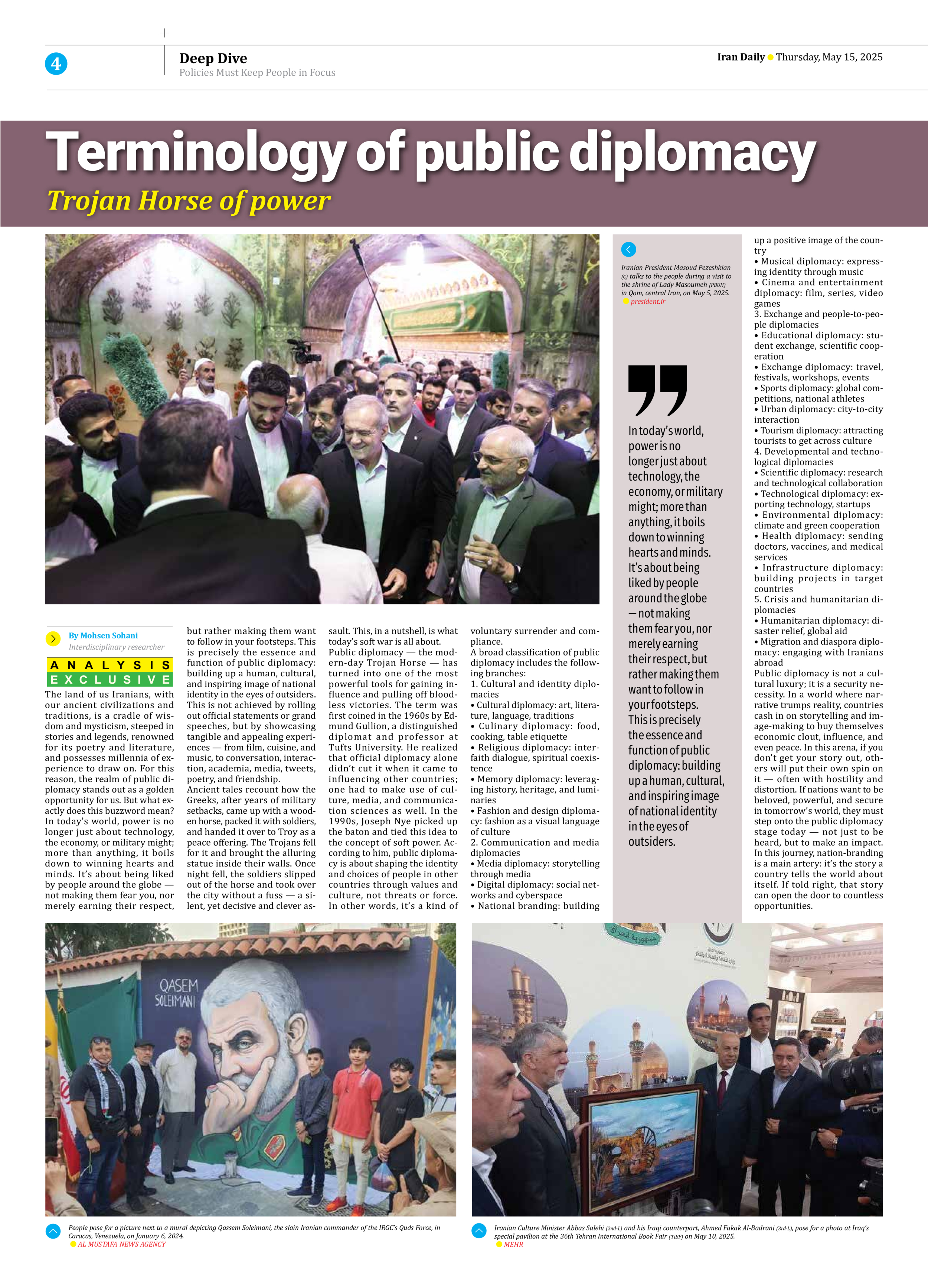
Terminology of public diplomacy
Trojan Horse of power
By Mohsen Sohani
Interdisciplinary researcher
The land of us Iranians, with our ancient civilizations and traditions, is a cradle of wisdom and mysticism, steeped in stories and legends, renowned for its poetry and literature, and possesses millennia of experience to draw on. For this reason, the realm of public diplomacy stands out as a golden opportunity for us. But what exactly does this buzzword mean?
In today’s world, power is no longer just about technology, the economy, or military might; more than anything, it boils down to winning hearts and minds. It’s about being liked by people around the globe — not making them fear you, nor merely earning their respect, but rather making them want to follow in your footsteps. This is precisely the essence and function of public diplomacy: building up a human, cultural, and inspiring image of national identity in the eyes of outsiders. This is not achieved by rolling out official statements or grand speeches, but by showcasing tangible and appealing experiences — from film, cuisine, and music, to conversation, interaction, academia, media, tweets, poetry, and friendship.
Ancient tales recount how the Greeks, after years of military setbacks, came up with a wooden horse, packed it with soldiers, and handed it over to Troy as a peace offering. The Trojans fell for it and brought the alluring statue inside their walls. Once night fell, the soldiers slipped out of the horse and took over the city without a fuss — a silent, yet decisive and clever assault. This, in a nutshell, is what today’s soft war is all about.
Public diplomacy — the modern-day Trojan Horse — has turned into one of the most powerful tools for gaining influence and pulling off bloodless victories. The term was first coined in the 1960s by Edmund Gullion, a distinguished diplomat and professor at Tufts University. He realized that official diplomacy alone didn’t cut it when it came to influencing other countries; one had to make use of culture, media, and communication sciences as well. In the 1990s, Joseph Nye picked up the baton and tied this idea to the concept of soft power. According to him, public diplomacy is about shaping the identity and choices of people in other countries through values and culture, not threats or force. In other words, it’s a kind of voluntary surrender and compliance.
A broad classification of public diplomacy includes the following branches:
1. Cultural and identity diplomacies
• Cultural diplomacy: art, literature, language, traditions
• Culinary diplomacy: food, cooking, table etiquette
• Religious diplomacy: interfaith dialogue, spiritual coexistence
• Memory diplomacy: leveraging history, heritage, and luminaries
• Fashion and design diplomacy: fashion as a visual language of culture
2. Communication and media diplomacies
• Media diplomacy: storytelling through media
• Digital diplomacy: social networks and cyberspace
• National branding: building up a positive image of the country
• Musical diplomacy: expressing identity through music
• Cinema and entertainment diplomacy: film, series, video games
3. Exchange and people-to-people diplomacies
• Educational diplomacy: student exchange, scientific cooperation
• Exchange diplomacy: travel, festivals, workshops, events
• Sports diplomacy: global competitions, national athletes
• Urban diplomacy: city-to-city interaction
• Tourism diplomacy: attracting tourists to get across culture
4. Developmental and technological diplomacies
• Scientific diplomacy: research and technological collaboration
• Technological diplomacy: exporting technology, startups
• Environmental diplomacy: climate and green cooperation
• Health diplomacy: sending doctors, vaccines, and medical services
• Infrastructure diplomacy: building projects in target countries
5. Crisis and humanitarian diplomacies
• Humanitarian diplomacy: disaster relief, global aid
• Migration and diaspora diplomacy: engaging with Iranians abroad
Public diplomacy is not a cultural luxury; it is a security necessity. In a world where narrative trumps reality, countries cash in on storytelling and image-making to buy themselves economic clout, influence, and even peace. In this arena, if you don’t get your story out, others will put their own spin on it — often with hostility and distortion. If nations want to be beloved, powerful, and secure in tomorrow’s world, they must step onto the public diplomacy stage today — not just to be heard, but to make an impact. In this journey, nation-branding is a main artery: it’s the story a country tells the world about itself. If told right, that story can open the door to countless opportunities.







